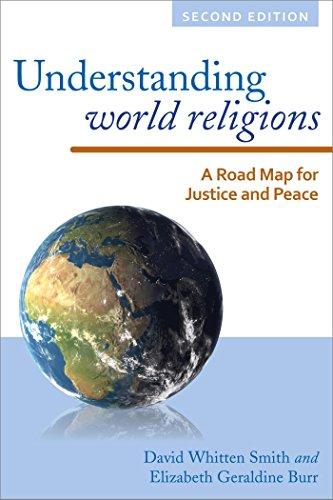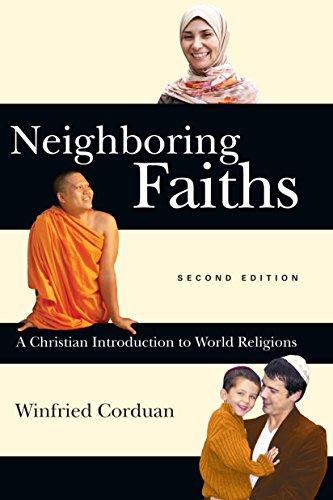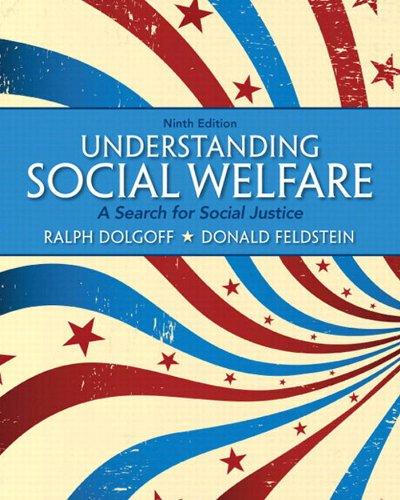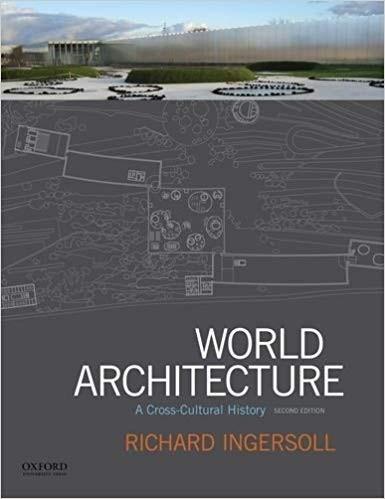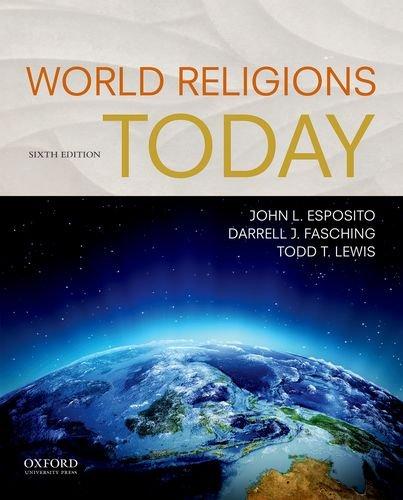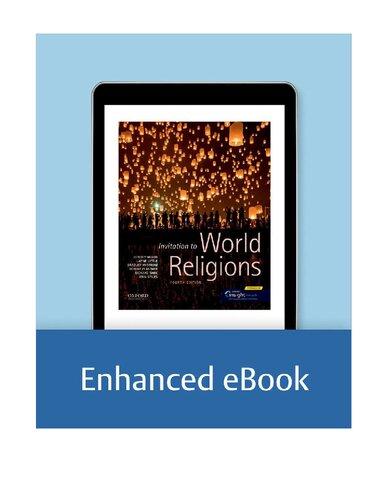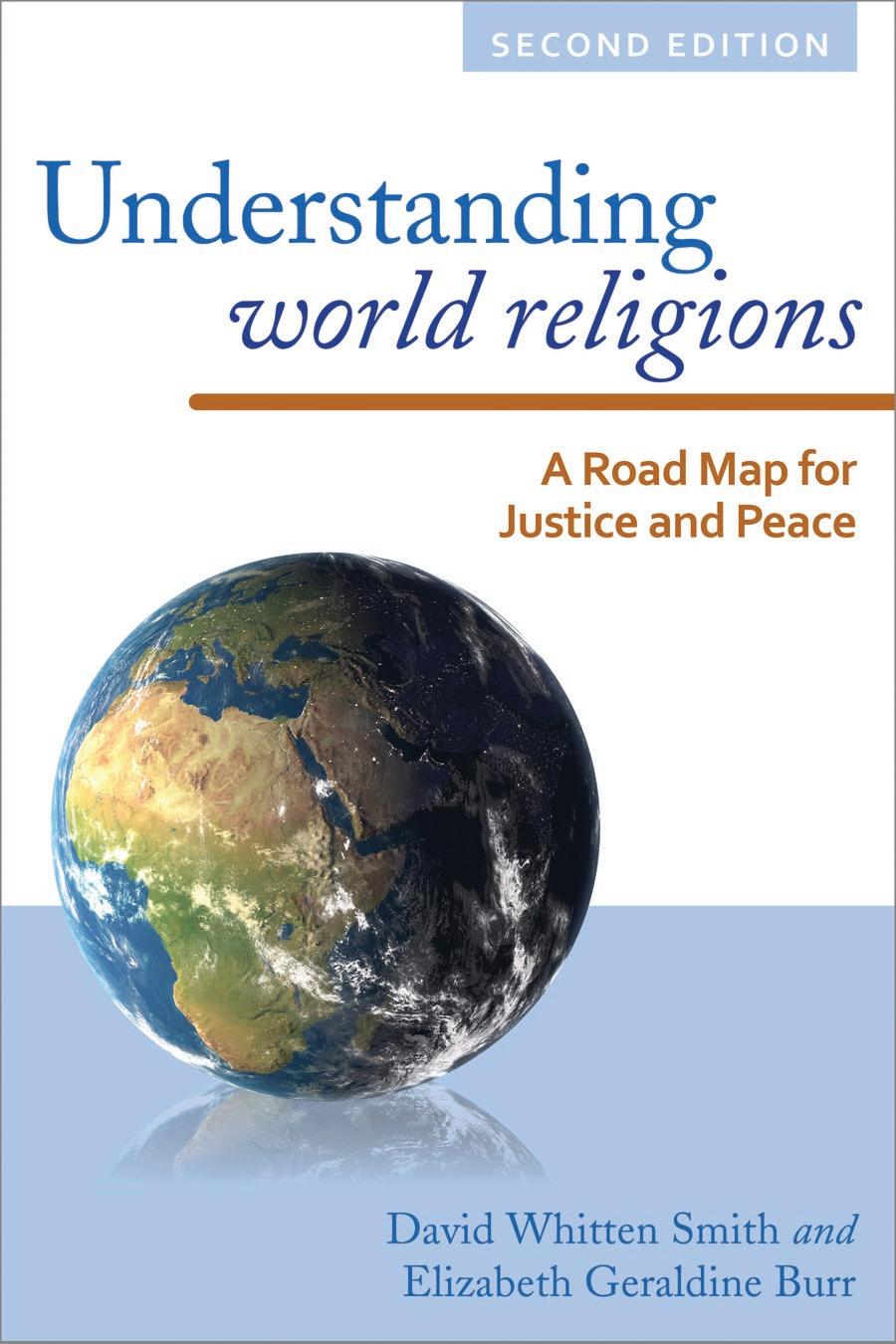Understanding World Religions: A Road Map for Justice and Peace 2nd Edition, (Ebook PDF)
Visit to download the full and correct content document: https://ebookmass.com/product/understanding-world-religions-a-road-map-for-justiceand-peace-2nd-edition-ebook-pdf/
More products digital (pdf, epub, mobi) instant download maybe you interests ...
Neighboring Faiths: A Christian Introduction to World Religions 2nd Edition, (Ebook PDF)
https://ebookmass.com/product/neighboring-faiths-a-christianintroduction-to-world-religions-2nd-edition-ebook-pdf/
Understanding Social Welfare: A Search for Social Justice – Ebook PDF Version
https://ebookmass.com/product/understanding-social-welfare-asearch-for-social-justice-ebook-pdf-version/
Integrating the packaging and product experience in food and beverages : a road-map to consumer satisfaction 1st Edition Burgess
https://ebookmass.com/product/integrating-the-packaging-andproduct-experience-in-food-and-beverages-a-road-map-to-consumersatisfaction-1st-edition-burgess/
(eTextbook PDF) for World Architecture: A CrossCultural History 2nd Edition
https://ebookmass.com/product/etextbook-pdf-for-worldarchitecture-a-cross-cultural-history-2nd-edition/
World Religions Today 6th Edition John L. Esposito
https://ebookmass.com/product/world-religions-today-6th-editionjohn-l-esposito/
Invitation to World Religions 3rd Edition Jeffrey Brodd
https://ebookmass.com/product/invitation-to-world-religions-3rdedition-jeffrey-brodd/
Invitation to World Religions 4th Edition Jeffrey Brodd
https://ebookmass.com/product/invitation-to-world-religions-4thedition-jeffrey-brodd/
Making Maps, Third Edition: A Visual Guide to Map Design for GIS 3rd Edition, (Ebook PDF)
https://ebookmass.com/product/making-maps-third-edition-a-visualguide-to-map-design-for-gis-3rd-edition-ebook-pdf/
Introduction to Criminal Justice: A Balanced Approach 2nd Edition, (Ebook PDF)
https://ebookmass.com/product/introduction-to-criminal-justice-abalanced-approach-2nd-edition-ebook-pdf/
BriefContentsv
Prefacexiii Introduction1 Traditions:Great,Little,Counterfeit,Hidden2 ReligionsandWorldviews4 TheSeven‘‘Dimensions’’5 ExperientialandEmotionalDimension7 SocialandInstitutionalDimension9 NarrativeorMythicDimension11 DoctrinalandPhilosophicalDimension13
PracticalandRitualDimension14 EthicalandLegalDimension16 MaterialandArtisticDimension17 TwoDangers22
IsStudyingOtherReligionsHarmfultoOne’sOwnFaith?23 Complexities23 DoReligionsCauseViolence?CanTheyPromotePeace?24 WhatLiesAhead26 Summary27 KeyTerms27 DiscussionQuestions27 SuggestionsforFurtherReading28 1 HinduWorldviews29 ExperientialandEmotionalDimension29 HistoricalPeriods30 NarrativeorMythicDimensionIncludingSacredWritings32 DoctrinalandPhilosophicalDimension32 PracticalandRitualDimension34 SocialandInstitutionalDimension37
DoctrinalandPhilosophicalDimension114
PracticalandRitualDimension121
EthicalandLegalDimension123
SocialandInstitutionalDimension126 IssuesforJusticeandPeace129 SpokespersonsforJusticeandPeace136 Summary138
KeyTerms139 DiscussionQuestions139 SuggestionsforFurtherReading140
5 MuslimWorldviews141
ExperientialandEmotionalDimension142 HistoricalPeriods143
SacredWritings144
NarrativeorMythicDimension145
DoctrinalandPhilosophicalDimension148
PracticalandRitualDimension150
SocialandInstitutionalDimension153
EthicalandLegalDimension155 IssuesforJusticeandPeace155 SpokespersonsforJusticeandPeace164 Summary167 KeyTerms168 DiscussionQuestions168 SuggestionsforFurtherReading169
6 NativeAmericanWorldviews171
ExperientialandEmotionalDimension171 HistoricalPeriods172
SacredWritings177
NarrativeorMythicDimension178
DoctrinalandPhilosophicalDimension178
PracticalandRitualDimension178
EthicalandLegalDimension179
SocialandInstitutionalDimension182 IssuesforJusticeandPeace183
SpokespersonsforJusticeandPeace190 Summary190
KeyTerms191 DiscussionQuestions191 SuggestionsforFurtherReading192
7 MarxistWorldviews193 ExperientialandEmotionalDimension193 HistoricalPeriods193
Preface
In1987,theUniversityofSt.Thomasinauguratedaminorinjusticeandpeace studies.Wedecidedthatitwouldbeimportanttostudyhowpeople’sworldviews affectthechoicestheymakethatpromoteorinhibitjusticeandpeace.Atthetime, ourprogramwasunusual.Notmanypeopleinthiscountryunderstoodwhyit wouldbenotonlyusefulbutevenessentialtounderstandotherpeople’sworldviews.AftertheSeptember11,2001,attacksontheWorldTradeCenterandthe Pentagon,thecountrystartedcomingaroundtoourpointofview.In1987,there wasnotextbookavailabletointroducewhatwewantedtotalkabout,soDavid Smithstartedtowriteoneandshareditwithhisstudentsinduplicatedformover histwentyyearsofteachingthecourses.ElizabethBurrbecamethebook’ssecondarycoauthorforthefirstRowman&Littlefieldedition(2007),andtogetherwehave co-revisedthetextforthesecondedition(2015).Manyotherpeoplehavehelped alongtheway.Thisbook,nowinitssecondedition,istheresult.
InthecourseTheologiesofJusticeandPeace,forwhichthisbookwasoriginally designed,inadditiontoreadinganddiscussingthisbook,eachstudentwasasked toresearchoneworldviewthatdiffersfromherown,usingaseriesofstepstoorganizeherstudy.Attheendofthesemester,studentsreadanddiscussedeachother’s projects.Whenweduplicatedthisbookinitsearlierformsfortheiruse,weincluded inthebookextensiveinstructionsandotheraidsforthatstudyproject.Sincewe couldnotpredicthowmanypeoplewouldbeinterestedbothinthecontentofthis bookandintheinstructionsforsuchaproject,wedecidedtoputtheinstructions ontheWorldWideWebathttp://courseweb.stthomas.edu/justpeace/Rowman .html.Herewewillbrieflydescribewhatisavailablethere.
DETAILEDPROJECTINSTRUCTIONS FORSTUDENTSANDFACULTY
Studentsareinstructedhowtostudyaworldviewaccordingtothefollowingeleven steps:
1.Describeyourownworldviewandpresuppositionsbyansweringtheninesets ofquestionsgiven.(Thosestepsaresummarizedintheintroductiontothis book.)Thisstepwillhelpyou(a)tothinkaboutmanythingsyouhavetaken forgranted,(b)tobecomeawareofthevarietyinourownclass,and(c)to acceptandvalueourdifferences.Thestepisgradedpass-fail.
2.Describewhatyouknowasyoubeginyourstudy:theworldviewyouhave chosentostudy,whatyouknowordon’tknowaboutitasyoustart,what youwanttofindout.
3.Selectalocalresourcetohelpyouwithyourstudy,preferablysomeonewho livestheworldviewyouarestudying.
4.Experiencetheworldviewthroughavicariousexperience—anarrativesuch asanovel,memoir,autobiography,film,play,interview,orforeigntravel. Wearelookinghereforstories,notyetforacademicinformationoranalysis.
5.Fromacademicresearch,describethemainideasandpracticesoftheworldview,especiallywithregardtojustice,peace,prosperity,andsecurity.
6.Listanddescribebrieflythemainsacredbooks,classics,andtraditions (includingoraltraditions)oftheworldview.Readpartsmeditativelyand reportontheexperience.
7.Describehowsomerealpersonhasbeeninfluencedbytheworldviewintheir workonbehalfofjusticeandpeace,orhowsomecommunitylivingthe worldviewhasrespondedinsomerealconflict.Thisstepwillconsiderwhat happenswhenonepersonoragroupattemptstoliveouttheworldview’s idealsintheactual,messyworld.
8.Rewriteyourresponsestothequestionsofsteponeasifyoupersonallyheld theworldviewyouhavebeenstudying.
9.Writeautopiathatwouldmakesensetosomeoneholdingtheworldview. Whatwouldaperfectworldbelike,whyisn’ttheworldlikethat,whatisthe bestsituationwemighthopeforintherealworld(a‘‘possi-topia’’),andhow mightwemovetowardthatbetterfuture?
10.Reflectonyourstudy.Comparewhatyouknowandbelievenowwithwhat youdidinstep2whenyoustarted.Didyourstudyconfirmyourexpectations,challenge,orsurpriseyou?Howhelpfulwasyourlocalresourceofstep 3?Howcouldthiscoursebeimproved?
11.Giveusalistoftheresourcesyouusedwithcommentsforfuturestudies indicatinghowusefuleachitemwas,andforwhatstepsitwasuseful.
Extensiveresourcelistsfortheproject:Forthelasttwentyyears,wehavebeen assemblingtheannotatedresourceliststhatour students haveproduced(step11 above)—youcansee their commentsonbooks,periodicalarticles,websites,and more.
OTHERTREASURESONOURWEBSITE
Spacelimitationshavepreventedusfrompublishingeverythingwewouldliketo share.Someofwhatdidn’tfitisalreadyorwillbeavailableatourwebsite.
• TwosetsofmapsshowingNativeAmericanandPalestinianlossofland.
• Footnotelistsforeachchapterandabibliographylist,allwithactivehotlinks, sothatonecanreadthebookinfrontofthecomputerornotepadandjump quicklytomaterialsmentionedinthefootnotesandbibliographywithaclick ofthemouseorataponthescreen.
• Overflowtopicsthatdidn’tfitandarementionedinthetextasavailableon ourwebsite.
• Expandedsuggestionsforfurtherreading.
• Additionalspokespersonsforeachworldview.
• AnarticleDavidwrotethatappliesmanyofthethingswetalkaboutinthe book;itiscalled‘‘InspiredAuthorsandSaintlyInterpretersinConflict:The NewTestamentonWarandPeace.’’
• AnarticleElizabethwroteaboutPalestinianChristians,whichsupplementsthe contentofchapter8;itiscalled‘‘OutofPalestine:SolidaritywithaDisplaced People.’’
• Furtherweblinks,studyquestions,additionaldiagramsandtables,photographs,andmaybeevenaPowerPointpresentationortwo.
Wewillcontinueupdatingthesecondeditiononthewebsite.
WHATISNEWINTHISEDITION?
Aswerevisedthebookforitssecondedition,weconsideredfeedbackfromreviews submittedtothepublisherplusothersources.Wewantedtobroadentheframeworkwherepossible,forexample,inchapter9,whichisnolongerstrictlylimited toaChristianperspective.Intheintroduction,weexpandedtreatmentofnonreligiousmoralnorms,andaddedasectiononthecounterfeittraditionsdeceitfully advocatedbypsychopaths.Inchapter5,weaddedsectionsonmodernismand Islamophobia.Inchapter6,wediscusshowindigenousculturesreacttocolonial evangelization,withspecialattentiontotheLakota,BlackElk,whobecamea RomanCatholiccatechist,andtoYorubaslavesintheAmericaswhocombined theirAfricanbeliefswithRomanCatholicismtocreatethesyncretisticreligionsof Santerı´a,Umbanda,Candomble ´ ,andVodou.Inchapter7,weaddedmaterialon howChinesereligionhasadaptedtoMarxismandsurvived.Inchapter8,we broughttheIsraeli-Palestinianstruggleuptodate.WeaddedmoreJewishandMuslimmaterialtochapters9through12.Inparticular,inchapter12weclarifiedhow JudaismandIslamrelatetothetenprinciplesofcommunalforce.Apartfromthese specificadditions,thebookhasbeenthoroughlyrevisedthroughout.
AFEWADMISSIONS
Thisbookisnotneutral;itdoesnottreatwar,peace,injustice,andjustice‘‘impartially.’’AsJohanGaltungpointsout,1 peacestudiesaresimilartohealthstudies— bothgobeyondimpartialunderstanding.Doctorsdon’tstudymedicinejustbecause
theyfinddiseasesintriguing;theywanttocurepeople.Wedon’tstudyworldviews justbecausetheyinterestus;wehopethatunderstandingthemwillhelpusfurther ourworkforjusticeandpeace.Finally,wehavetriedtomakethebookinteresting ratherthancomprehensive.Wesincerelyhopethatyouwillfindourwork(eventhe secondtime)compellingbutincomplete,sothatyouwillbemovedtoexploreon yourownsomeoftheareasweintroduce.
Thetwoofuscomefromdifferentbackgroundswithsomewhatdifferentperspectives,althoughwesharesignificantcommonground.DavidisaRomanCatholicpriestwithadoctorateintheologyandalicentiateinsacredscripture.Acovenant memberofServantBranchofthePeopleofPraise(aChristianecumenicalcharismaticcommunity),hehasstudiedinRomeandJerusalem,andhastraveledextensivelytoresearchsacredscriptures,religions,andmovementsforjusticeandpeace throughEurope,theMiddleEast,SouthAsia,Africa,theCaribbean,andCentral andSouthAmerica.Hehasservedonapeaceteamintheoccupiedterritoriesof GazaandtheWestBank.Elizabeth’sformalreligiousbackgroundisProtestantEpiscopal.Herdoctorateisinthestudyofreligion.InadditiontointroductoryuniversitycoursesinChristianity,especiallytheNewTestament,shehastaught‘‘The WorldofIslam’’numeroustimes,aswellasseveraljusticeandpeacecourses.Since 1970,shehasvisitedIsrael-Palestineanumberoftimesandisinvolvedwithothers inseekingajustresolutiontothisconflict.SheisalsoatrainedJungiananalyst. Furtherbackgroundinformationforbothwillbeavailableonourwebsite.
ACKNOWLEDGMENTS
Manypeoplehavehelpedthisbooktakeitscurrentshape.WeexpresssinceregratitudetoTathaWiley,whooriginallyintroducedustoRowman&Littlefield.Weare alsoespeciallygratefultoAnneKing,whowrotealargepartofchapter7onMarxist worldviews,toJackNelson-Pallmeyerforhiscontributiontochapter4onChristian worldviews,andtheninpreparationforthebook’ssecondedition,toEdward(Ted) Ulrichforreviewingchapters1–2,SusanStabileforreviewingchapter2,DavidPenchanskyforreviewingchapters3–4,andSamirSaikaliforreviewingchapter5.We areequallygratefultoRossMiller,ourfirsteditioneditoratRowman&Littlefield, forhiseditorialguidance,andnowtoSarahStantonforherexpertoversightand patienceduringtheprocessofrevisingthebookaswellastoJehanneSchweitzer forherfineworkasproductioneditor.Weappreciatethehelpfulcommentsof reviewersofthefirstedition:PrathibaNagabhushanforthe InternationalJournalon WorldPeace,CarloFiliceforthe JournalforPeaceandJusticeStudies,andAndrea WislerandBethanyHaworthforthe JournalofReligion,Conflict,andPeace.Others whohavereadandofferedhelpfulcommentsonvariouschapters,whohavetaught thecoursethebookwasdesignedfor,whohavehelpedDavidoutwithhisvarious studytrips,orwhoinotherwayshavehelpedusgathersignificantmaterialand experiencecontainedinthisbook,includeZevAeloni,D.C.Ahir,Fr.Antonio d’Agostino,A.T.Ariyaratne,Rev.NaimAteekandothersatSabeelinJerusalem,
MubarakAwad,KedarBahadurBasnet,Fr.TissaBalasuriya,JeffCarlson,Dennis Carroll,SorayaCastro,WilliamCavanaugh,MichaelCullen,thelateDavidDellinger,LornaDewaraja,Rev.NoelDias,Fr.PeterDougherty,RabbiAmyEilberg,Jay Erstling,H.R.H.ChiefFonkemAchankengI,ArunGandhi,GiselleGarciaCastro, thelateFr.RafaelGarcı´a-Herreros,thelateIraGordon,thelateNedHanauer,Linda Hulbert,thelateAbp.DennisHurley,Fr.DiegoJaramillo,JamesJennings,Michael Klein,JonathanKuttab,CarolScherstenLaHurd,JohnLandgraf,MarthaLarsen, RamuManivannan,OrlandoMarquez,PatrickMawaya,AshokMehrotra,Jose ´ Mı ´ guezBonino,Fr.HugoMontero,FredNairn,MichaelNaughton,Leuben Njinya-Mujinya,MichaelNovak,thelateArshamOhanessian,AdilOzdemir,Rev. GeorgePalackapilly,AgapitosPapagapitos,SantiagoPe ´ rezBenitez,Fr.Aloysius Pieris,VivekPinto,CalvinRoetzel,thelateFr.GregSchaeffer,GeraldSchlabach, SylviaSchwarz,JuanLuisSegundo,Dr.SunitiSolomon,PadreDagobertoSotelo, Sr.FlorenceSteichen,AhmedTharwat,CrisToffolo,HeidiTousignant,Dr.SolomonVictor,GeraldVizenor,Sr.LizWalters,IraWeiss,SusanWindley-Daoust,Fr. AlexZanotelli,andFredZimmerman.WearegratefultocolleaguesintheAmerican AcademyofReligion,theCatholicBiblicalAssociation,theInternationalPeace ResearchAssociation,thePeaceandJusticeStudiesAssociation,andtheSocietyof BiblicalLiteratureattheUniversityofSt.Thomas,theotherUniversityofSt. ThomasinRome(the‘‘Angelicum’’),theCatholicUniversityofAmerica,theE ´ cole BibliqueetArche ´ ologiqueFranc ¸ aise(Jerusalem),andtheEuropeanPeaceUniversity(Stadtschlaining,Austria).
ElizabethexpressessincerethankstotheTheologyDepartmentandtheJustice andPeaceStudiesDepartmentattheUniversityofSt.Thomasforagrantthat enabledhertodevotesignificanttimetopreparingthebook’ssecondedition.
Andnowthebookisinyourhands.WepraythatGodwillhelpyoutounderstand,appreciate,andputintopracticewhateverwehavesaidthatistrueandhelpful,andtooverlookorignorewhateverwehavesaidthatisnot.
DavidWhittenSmith
ElizabethGeraldineBurr
TheStudyofWorldviews
[Humans]expectfromthevariousreligionsanswerstotheunsolvedriddlesof thehumancondition,whichtoday,evenasinformertimes,deeplystir [human]hearts:Whatis[ahuman]?Whatisthemeaning,theaimofourlife? Whatismoralgood,whatsin?Whencesufferingandwhatpurposedoesit serve?Whichistheroadtotruehappiness?Whataredeath,judgmentandretributionafterdeath?What,finally,isthatultimateinexpressiblemysterywhich encompassesourexistence:whencedowecome,andwherearewegoing?
—NostraAetate1
Talkaboutjusticeandpeacecanbefrustratingwhenmyworldview(setofpresuppositions)differsradicallyfromyours.Yourcommentsmaynotevenmake sensetome.Thisisespeciallytrueforpeoplefromdifferentpartsoftheworldor fromgroupsholdingradicallydifferentreligiousorideologicalbeliefs.Butmanyof themostdifficultworldconflictsseemtotakeplacebetweensuchgroups:Jews, Muslims,Christians,andMarxistsinIsrael-Palestine;Hindus,Muslims,andSikhs inIndiaandPakistan;HindusandBuddhistsinSriLanka;MarxistsandChristians inNorthKoreaandCuba;andsoforth.Conflictsalsooccurbetweensubgroups withinamajorworldview,forexample,ProtestantsandCatholicsinNorthernIreland,orSunniandShiaMuslimsinIraq.
A worldview isanoverallwayofseeingandrelatingtotheworldweliveinand anylargerworldthatmaybebeyondourworld.Itasksaboutthemeaningofwhat weexperienceandhowweshouldrespondtothepeople,forces,andthingsthat surroundus.Thisbookseeks(a)tohelpyoudecidewhetheritistruethatunderstandingotherworldviewspromotesjusticeandpeace,(b)tohelpyoulearnthe mostbasicelementsofsomeworldviewsyouarelikelytoencounterasyoupursue justiceandpeace,and(c)toteachyouhowtostudyotherworldviewsinasympatheticwaysothatyoucanunderstandwhyothersthink,feel,andactthewaythey do,anticipatetheiractions,andperhapsenrichyourownworldview.
Wehopethisbookwillreduceyourfearofpeoplewhoseviewsoftheworlddiffer fromyours.Wealsohopeitwillencourageyoutoexamineyourownworldview moredeeplysoastoembracethoseofitsdynamicsthatpromotejusticeandpeace, andtoresistorreshapethosethatpromoteself-interestedprivilegeandviolence. Youmayfindthatmuchofwhatyouhavepresumedtobecommonsenseheldby allreasonablepeopleisratherpartofyourownparticularworldviewandopento criticalchallenge.Inmulticulturalsocieties,peopledisagreeaboutwhatconstitutes ‘‘commonsense.’’
Noneoftheworldviewsfeaturedherewillbepresentedcompletely,butyoucan becomeawareofhowworldviewsinfluenceotherpeople’svisionandjudgmentso thatyouwillbelesssurprisedbyhowtheyreact.Youwilllearnwhatneedstobe investigatedtoclarifypositions:whatimplicitclaimsandquestionslieconcealed beneaththesurfaceofanargument,andwhatvaluesareatstakeintheanswersto thosequestions.
Thisbookwillbrieflyexplainseveninfluentialworldviews:Hinduism,Buddhism, Judaism,Christianity,Islam,indigenous(mostlyNativeAmericanwithsomeattentiontotheYoruba)religions,andMarxism(withsomeattentiontoChinesereligions).Inchapter8wepresenttheIsraeli-Palestinianissueasacasestudyof worldviewsinconflict.WealsogivespecialattentiontoChristianandotherreligioussocialteaching,liberationtheologies,activenonviolence,andjustwartheories becausetheyillustratehowreligiousbeliefsinfluenceattitudesandactionstoward justiceandpeace.
TRADITIONS:GREAT,LITTLE,COUNTERFEIT,HIDDEN
Whatinfluencesone’sattitudesandactionsisnotnecessarilytheworldviewthat one claims tohold,butrathertheworldviewthatone actually holds.Peopleare oftenunawareofthedifferencebetweentheirallegedworldviewandtheactualprinciplesthatgoverntheiractions.Inaddition,somepeopledeliberatelylieabouttheir worldviewandprinciples.
The greattradition denotesthewayaparticulartraditionis taught byitsmost enthusiasticleadersandpractitioners, developed bymajorwritersandapologists (propagandists),and expressed initssacredandclassictexts. Incontrast,the little tradition denotesthewaymanypeople—oftenonlyvaguelycommittedtotheprinciplesofaclassictradition—are actuallylivingout theworldview.Littletraditions tendtofocusonimmediate,short-term,individualdesiresandpleasures;greattraditionsencouragepeopletosacrificethosedesiresandpleasuresinfavorofdeferred, long-term,sociallysharedgoals.
Inthisbook,the counterfeittradition denotesthedeceptivevaluesandprinciples falsely claimedbysomepeopletojustifytheiractions—theydon’tactually believeinthemoractonthem;andthe hiddentradition denotesthe actual values, principles,andgoalsthatmotivatethesedeceptiveactors.Thelasttwotermsare
notcommonlyused,buttheirrealityisenormouslyimportantforunderstanding worldinjustice.
Psychologicalresearchhaschallengedthepopularnotionthatallhumanshavea conscience—abasicunderstandingofrightandwrong—despitethedifferentforms itmighttakeindifferentpeople.2 Butjustassomehumansarebornphysicallycrippledorbecomecrippledthroughanaccident,somehumansarebornwithout any capacitytosenseorunderstandwhatotherpeoplearefeeling;otherslosethiscapacitythroughaccident,disease,orearlytraumaticlifeexperience.Theyareasincapableofunderstandingwhatotherpeoplemeanby‘‘compassion’’or‘‘empathy’’asa colorblindpersonisincapableofunderstandingwhatotherpeoplemeanby‘‘red’’ or‘‘green.’’Normalpeopleareusuallyunawareofthesepeople’shiddentradition: thelatterexperiencenodoubts,noregrets,andnoshameforanythingtheydo. Theylieconstantlywithnorestraintandnoemotion.Theybelievethattheyare exceptionallytalented,althoughtheyseldomare.Theystillmakechoicesonthe basisoftheir(hidden)worldview,butthatworldviewtakesnoaccountofother people’sfeelings.Likeanewborninfant,theysimplyseekwhateverfeelsgoodto themwithnoattentiontoanyoneelseexceptinsofarasotherscanmeettheir desires.Earlyintheirlives,theybecomeawarethatmostpeoplearedifferent,and theybecomeadeptat pretending tohavecompassion.Butthecontrastbetweenwhat theysayandwhattheydoeventuallyrevealstoperceptivepeoplethattheynotonly don’t have compassion,theydon’tevenknowwhatcompassion means.Themost dangerousofthesehandicappedpeoplearecalled psychopaths.
Somepsychopathsbecomeserialkillersorothertypesofcriminals.However, manysucceedinhidingtheirhandicapandgainingpositionsthatpromisewealth orpower—especiallyinpoliticsandbusiness.Theyhidetheirhandicapbyusingthe morallanguageofacceptedworldviews,buttheydistortthemeaningofthewords theyuse—wordslike freedom or democracy—creatingacounterfeittradition,and theydonotactaccordingtothevaluestheyclaimtohold.Rather,theyactaccordingtotheirhiddentraditiontogainwhattheywantwithoutregardforanyoneelse.
Itwouldbecomfortingtothinkthatthesepeoplearerare,butresearchreveals that0.5percentto1percentofhumansare‘‘essentialpsychopaths’’byheredity, andaboutanother5percentlosetheircapacityforconsciencethroughbraininjury, disease,toxicpharmaceuticals,orearlychildhoodtrauma.3
Sometimesthesepeoplesucceedintakingcontrolofanationorculture,ashappenedinNaziGermanyandStalinistRussia.4 Theircounterfeitappealstowidely heldvaluescanconfuseordinarypeopleandleadthemtocooperatewithdisastrous andcriminalpolicies—aggressivewar,repression,genocide.Another12percentof peoplecan suppress theirconscience(atleastforatime)andcooperatewiththe psychopaths,believingthatthisistheonlywayto‘‘getahead’’orhaveaninfluence ontheactualworld.5 Onceaculturehasbeencapturedbythis18percent,alarge shareoftheremainingpopulationislikelytogoalongwiththeleadershipbecause theyacceptastruethecounterfeittraditionpreachedbytheleaders,areconfused bythedistortedwaythattraditionispresented,andlacktheself-confidencetoresist theleaders.AfamousseriesofpsychologicalexperimentsbyStanleyMilgraminthe
UnitedStatesintheearly1960sshowsthatmostpeoplewilldefertopeoplein authority,evenagainsttheirownconscience,toanastonishingandfrightening degree.6 Likewise,thebook TheyThoughtTheyWereFree documentshowGermans underNazirulefailedtoconfronttheirleaders,whomtheysawas‘‘bigpeople,’’ whereaseventheprofessionalsamongthemsawthemselvesas‘‘littlepeople’’who werenotqualifiedtogetinvolvedinpolitics.7
Moraloutrageatthetruepsychopathsiscounterproductive,sincethey reallyare incapable ofunderstandinghowtheiractionsaffectotherpeople.Whatasociety needstodoisto recognize thesituation(thefalsityofthecounterfeittraditionthese leadersappealto,andtheinfluenceofthehiddentraditionthatexplainswhatis actuallyhappening)and refusetocooperate withtheirplans.
Full-blownpsychopathscannotbetreatedpsychologically,sincetheydon’t believethatthereisanythingwrongwiththem.Treatmenteffortsjustteachthem newwaystomanipulateordinarypeople.
Fortunatelymostpeoplestillhaveafunctioningconscience.Eventually,often aftergreatsuffering,theyrealizewhatisgoingon.Somethenrefusetocooperate withthecorruptedleadership,orevenopposeitactively—atgreatpersonalcost. Othersfindsaferwaystoactinefficientlyorinterferesecretly,thusweakeningthe powerofpsychopathicevil.
Whilethisbookwillmakesomereferencetocounterfeitandhiddentraditions, itwillprimarilyseektounderstandthegreattraditionsofmajorworldviewsandto encouragepeopletoact‘‘creatively,compassionately,andnonviolently’’8 inline withthemostpositivecharacteristicsofthesetraditions.
Whenonebelievesinagreattradition,onetruststhedoctrinalteachingsofthat religionorworldviewandactsonthem.Butmanymembersofareligion,evensome ofthosewhocarefullythinkthroughitsimplications,arenotsosurethatthegreat traditionisright.Theyactonwhattheythinkis really true—theirlittletradition ratherthanonwhatthey aresupposedto thinkistrue. Psychopaths cannotunderstandtherulesatall—therulesseemlikenaı¨venonsensetothem—buttheymay appealtotherulesdeceitfullytogainthesupportofordinarypeoplewhileviolating thoserulesbytheirownactions.
RELIGIONSANDWORLDVIEWS
Someworldviewsarecalled religions. Others,likeMarxismandsecularhumanism, arenot.Still,secularworldviewsactlikereligionsinmanyways.
MostWesternerspresumethattheyknowwhatareligionis:itissomethinglike Christianity,orJudaism,orIslam;itbelievesinsomethingbeyondthe‘‘ordinary’’—inGodorgods,someunseenPowerorpowers,somethingbeyondcommon,everydayexperience.YetwhenWesternscholarsbeganstudying‘‘world religions,’’theyfoundthatmanypeoplesdon’tevenhaveawordforreligion.
HowmuchdoesaworldviewlikeHinduismhavetobe‘‘like’’Christianityto qualifyasa‘‘religion’’?Isthereanysingle‘‘thing’’thatwemightcallHinduism?
(Eventheword‘‘Hinduism’’wasinventedbyWesterners.)Forthatmatter,isthere asinglethingwecancallChristianity?Ratherthandecidethesequestions,wewill study‘‘worldviews’’asamoregenericreality.Wewillconsiderseveral‘‘dimensions’’ thatarewidely,ifnotuniversally,sharedbyworldviews,andwewillpresumethat everyoneintheworldhas(1) atleastsomeexperienceofsomething,(2) atleasta shadowysenseofwhattheyareexperiencing,and(3) apreferredorhabitualwayof understandingandrelatingtowhateverthatis.
Aswecarryoutthisstudy,wewillkeepinmindseveralquestionsthathelpfocus ourattentiononhowourworldviewsaffecthowweactforjusticeandpeace.More detailregardingthequestionsisavailableonourwebsite.9 Worldviewsdisagreeover howtoanswerthesequestions:
1.Istheresomethingabouthumanityasitactuallyexiststhatmighthelp explain thepersistenceofwar,oppression,torture,criminalactivity,corruption,quarrels,andbrokenrelationships?Ifso,whatisitabouthumanitythathasthese effects,andwhatisthecauseofthissituation?
2.Dependingonyouranswertoquestion1, whatmightbedone torespondto therealsituationofhumans?Canwemakethesechangesforourselveswithoutoutsideaid?Whatkindofaidmightweneed?
3.Doesan invisibleworld interactwithourworldofexperience?Dospiritual powerscareaboutusoranswerprayers?Dowesurvivedeath?
4.Howdowe decidewhatactionsaregood? Through‘‘secular’’experienceand study,divinecommand,theexampleofareligiousleader,apersonalrelationshipwithGodorotherspiritualpower,ourownintuition,or‘‘common sense’’?
5.Whydoes suffering exist?Doesithaveanypositivepurpose?Whatshouldwe doaboutit?
6.Whatisthe purposeofhumanlife? Whatissuccess?Whatbringshappiness? Howdoesthisliferelatetoapossiblefuturelife?
7.Whatdoes justice mean?Equality?Thefreedomtokeepwhatonehasearned? Isjusticeforothersasimportantasjusticeforoneself?
8.Whatcanwebe secure aboutorconfidentlycontrol?Howdowehandlefeelingsofinsecurityorpowerlessness?Isitallrighttomaintainoursecurityat thecostofsomeoneelse’swell-being?
9.Areweprimarilypromotingordefending goodness,justice,peace,freedom, security, or prosperity?Forwhom? Whatshouldwebedefending? Can wedo soeffectively,withoutcausingmoreharmthangood?Can forceorviolence be justifiedintheirdefense?Can nonviolence beequallyormoreeffective?
THESEVEN‘‘DIMENSIONS’’
Inhisbook TheWorld’sReligions, 10 NinianSmartproposessevendimensionsthat arecommontoallormostreligions.11 Theyarenot‘‘pieces’’ofareligionorworldviewasmuchas‘‘viewpoints’’or‘‘aspects.’’Asamaterialobjecthasthree‘‘dimensions,’’andallthreearedimensionsofthesamething,soareligionorworldview
hasseven‘‘dimensions.’’RearrangingSmart’sordertomakethemeasiertorememberandtoshowconnectionsbetweenthem,thesesevendimensionsare:
1. Experientialandemotional—peoplegainexperienceoflife;somepeoplehave life-changingexperiences.
2. Socialandinstitutional —theyseekoutotherswithsimilarexperiencesand formgroupsforsupport;graduallythesegroupsgrowinsizeandcomplexity.
3. Narrativeormythic—withinthegroup,theypassontheirexperiencesinthe formofstories.
4. Doctrinalandphilosophical—aspeopleaskquestionsabouttheexperiences andthestories,theyexplainthemrationallyasbesttheycan—someofthe meaningcannotbeexpressedrationally,butmustremainasexpressedinthe storiesthemselves.
5. Practicalandritual—iftheyunderstandtheirexperiencestorelatetopowers orbeingsbeyondvisible,everydayexperience,theyworkoutconcretewaysof relatingtothosepowersorbeings(forexample,throughliturgyorworship); theyalsoworkoutformalizedwaysofrelatingtoordinarypeopleandthings (forexample,socialetiquette).
6. Ethicalandlegal—theydecidewhatactionsandwayoflifeareappropriateto theirexperiencesandtheirunderstandingofthoseexperiences;theyalso developlawstogovernthecommunitiestheyhaveformed.
7. Materialandartistic—inlivingouttheprecedingsixdimensions,theyproduce materialthings(buildingsliketemples,songslikehymns,visualarts,literature likedramaandpoems)thatareappropriatetotheirexperiencesandtheir understanding.
Inbrief,people haveexperiences (1); cometogether withothers(2); trytoshare andunderstand theirexperiencesinstory(3)andreasoneddiscourse(4);andseek to liveout theirexperiencesinsolemnorsacredacts(5),ordinaryacts(6),andthe materialfacilitiestheycreate(7).
Thisorderhasacertainlogicalattractivenessandwasprobablytheorderinwhich thefoundersoftheworldviewandearlyconvertstotheworldviewexperienced thesedimensions,butitisnottheorderinwhichmanylaterfollowersexperience them.Mostpeopleare‘‘borninto’’aparticularreligionorworldview—socialized intoitwithintheirfamily.Whiletheybeginlifewithindividualexperiences,these arenottheexperiencesmostcentraltotheirparents’worldview.Perhapsthefirst dimensiontheyexperienceis(6):‘‘Johnny,don’tdothat!’’Whentheyaskwhynot, theyaremorelikelytogetanarrative(3)thandoctrine(4),sincetheyaretooyoung fordoctrine.Theyalsoexperiencethesocial(2),ritual(5),andmaterial(7)dimensionsbeforetheyunderstandthereasonsforthem.Astheygrowolder,theymay getagooddoseofthedoctrinaldimension(4)throughsomeformofreligiouseducationbeforetheyfinally(ifever)sharethecoreexperiences(1)thatarethebasis foralltherest.
Whenpeoplewhowerebornintoaworldviewdofinallysharethecoreexperiencesthatunderlieit,theyfindthateverythinghasdeepermeaningthantheyhad realized—therest‘‘comestolife.’’Oftentheyhavetorethinkitall.Thisiscalled ‘‘adultconversion’’—notconversionfromoneworldviewtoanother,butconversionofapersonfromamerelytheoreticalknowledgeofaworldviewtoadeeply personalrelationshipwithit.
Nowletuslookateachdimensioninmoredetail.
EXPERIENTIALANDEMOTIONALDIMENSION
ManyWesternersfirstencounter‘‘mysticism’’inacontextofFarEasternreligious thought,perhapsthroughtheNewAgeMovement,HareKrishna,orTranscendentalMeditation.Conceptslikeyogis,reincarnation,theillusorynatureofeveryday reality,‘‘mindovermatter,’’andastralprojectionareforeignideastotheWestern mind.Somearethensurprisedtohearthatthereisalong-standingandwidely developed Christian mysticaltradition12 that describes experiencesoftensimilarto thoserecountedinFarEasterntraditions,whileit understandsandexplains them differently.Youcanreadaboutavarietyofmysticalexperiencesfrommanydifferenttraditionsin TheVarietiesofReligiousExperience bytheAmericanpsychologist andphilosopherWilliamJames.
SociologicalSupport
ImpressedbyJames’sbook,theAmericansociologist-priestAndrewGreeley,ina nationalsurveyof1,500averageAmericans,addedafewquestionslookingformystics.Heasked,‘‘Haveyoueverhadthefeelingofbeingveryclosetoapowerful spiritualforcethatseemedtoliftyououtofyourself?’’Hewasastonishedtofind that40percentofhissamplesaid‘‘yes,atleastonce’’;20percentsaid‘‘several times’’;and5percentsaid‘‘often.’’Heaskedthemhowintensetheexperiencewas. Two-thirdsofthemputitatthetopofaseven-pointscale.Hegavethemasimple psychologicaltesttoseewhethertheywereall‘‘crazy.’’Theycameouthealthier psychologicallythananyothergroupwhohadevertakenthattest.
Hewasdisappointedwhensomeofhiscolleaguesdismissedhisresultswithout discussionandhecouldn’tattractmoneyforfurtherresearch.Hethoughtthata groupshowingsuperiorpsychologicalhealthwhoreportedhavingmysticalexperienceswasworthinvestigating. Other colleagues—professionalsociologists— approachedhimquietlytoaskwhetherhemightbeinterestedin their mystical experiences.13
MysticalExperience
Mysticalexperiencesarehardtoputintocategories,buttherearesomecharacteristictypes.
NuminousExperiences
Onetypehasbeencalled numinous experiences.ThenamecomesfromtheLatin word numen,whichreferstoalocalspiritbelievedtoinhabitabrook,groveoftrees, mountain,orothernaturalfeature.Experiencesofthissortbringusintocontact with apresencethat(a)attractsuswhile,atthesametime,(b)sendingathrillofawe orfeardownourspines.Pictureyourselfwalkingthroughagraveyardattwoo’clock inthemorningjustasashadowyshaperisesfromtheground.AnumberofJewish prophetsdescribetheirvisionsinwaysthatseemtofitthistype.SeeingGod,Isaiah fallsflatonhisfacecrying,‘‘Woeisme’’(Isaiah6:5).Paulfallstothegroundwhen heseesabrightlightandhearsthevoiceoftherisenJesus,hisexpectationsofarrestingChristiansinDamascusshattered(Acts9:4;22:7;26:13f).Fearisnotalwaysthe dominantelement.Somenuminousexperiencesaredominatedbythefeelingof loveandjoy.Still,thereisasenseofcontactwithsomeoneorsomething‘‘different’’ or‘‘Other’’—somethingpowerfulthatwedon’tcontrol.
Pan-en-henicExperiences
QuitedifferentisamysticalexperiencemoretypicalofHinduism,thoughnot unknownamongChristians.14 Inthisexperience,technicallytermed pan-en-henic (literally:‘‘all-in-one’’),themysticfeelsherselfunitedwithallofreality.Farfrom feelingfearoraweinthepresenceofan Other,themysticfeelsalmostalossofthe senseof self,whichcanalsobefrightening.Manyyogicexercisesaredesignedto leadapersonintoapan-en-henicexperience.Theyogisbelievethatsuchanexperienceshowsuswhattheworldisreallylike.
ShamanicExperiences
Athirdtypeofmysticalexperienceiscommonamong shamans.Thesearereligious leaderswho,eitherwithoutwillingitorthroughadeliberatevisionquest,passfrom thisworldtoanother,haveexperiencestherethatendowthemwithpower,and thenreturntothisworld—oftencarryingthemarksofthejourneyinchronicillness orwoundedness.Havingmadethatjourney,theycanusetheirpowertohelpothers. Youwillfindaccountsofshamans’visionsinNativeAmericanliterature,forexample,theclassicbook BlackElkSpeaks 15
‘‘BornAgain’’Experiences
Afourthtypeisthe‘‘bornagain’’experienceofadultreligiousconversion,either intoone’sownreligionorworldview,nowseeninanewway,orintoacompletely newworldview.Typically,asurrenderoffaithleadstointenseexperiencesofconvictionandjoyandtoanewclarityaboutthemeaningofdoctrinesthatwerepreviously‘‘acceptedonfaith’’withoutunderstanding.TherearenumerousChristian accountsofthe‘‘bornagain’’experience,especiallyinEvangelicalandPentecostal
literature.Anexampleofthe‘‘bornagain’’typeoutsideofconfessionalchurchcontextsistheAlcoholicsAnonymousexperienceofsurrenderfollowedbygroup explorationofthe‘‘twelvesteps,’’whichsuddenlytakeonnewlifeandnewpower.
MoreSubtleExperiences
Manymysticalexperiencesdon’tfitneatlyintoanyofthesecategories.Eventhe 60percentofpeoplewhoanswered‘‘no’’toAndrewGreeley’squestionmaywell experiencefeelingsofamoresubtleintensitythatgivemeaningandjustificationto theworldviewstheyhold.Ourdeepconvictionscanbesupportedbyemotionsfelt atthebirthofachild,atthedeathofafriend,whilewalkinginnature,duringa religiousritualsuchasCommunionatMassorthesingingofhymns,orwhensittingquietlyinprayer,perhapsinaholyplace.Evensuchasimplefeelingasthe thrillofhearingournationalanthemplayedduringtheOlympicGamesgrowsout ofandgivessupporttoourcommitmenttoeachotherascitizensofournation. Ifonehassuchexperiences,andif—asissometimesthecase—theydon’tfollow theusualrulesoftimeandspace,theymaybedifficulttodescribetoothers.One usuallybeginsbytellinganarrativeormyth,ourthirdcategorybelow.Butfirst,one mayseekoutotherswhohavehadsimilarexperiences,leadingthemtocreatesocietiesandinstitutionsoflike-mindedpeople.Thisbringsustothesocialdimension.
SOCIALANDINSTITUTIONALDIMENSION
Whenpeoplesharealife-changingexperience,theycometogethertosupport, encourage,anddiscussitwithoneanother.Theirassociationeventuallytakeson concrete,institutionalforms.Differentworldviewsproducedifferenttypesofcommunities.Islamhasbeenparticularlywellorganizedsocially.Itgivescentralimportancetothe umma,orreligiouscommunity.SinceforMuslimseveryaspectoflife shouldbemarkedbysubmissiontoAllah,theyseenoreasontoseparatereligion andstate.
InstitutionalFormswithinaReligionorWorldview
Religiousgroupsorganizethemselvessociallyinaself-consciousway,sincetheir senseofbeingincontactwithaspiritualrealitygivesthemadeepawarenessof sharedexperienceandmovesthemtocometogetherforcommonworship.Differentreligiousgroupspreferdifferentinstitutionalforms.ManyProtestantchurches haveafairlydemocraticstructure.TheRomanCatholicChurchhasamonarchical internationalstructure,althoughitisbecomingmoredemocraticatthelocal,parish level.Butthesearebroadgeneralizations.Majorchurcheschangetheirstructures overtime,adaptingthemtolocalconditions.
Institutionalleadershipisnottheonly,orperhapseventhemostimportant,kind ofleadershipinchurches.Thereisalsotheleadershipofsanctityandspiritualexperience.Sufis,prophets,andsaintsmayelicitmorereverencethancaliphs,chiefrabbis,andbishops.Respectedlocalchurchgoersandactivistsmaybemoreinfluential thanimams,preachers,andpastors.Reflectonthesocialstructuresinwhatever churchoranalogousgroupyoubelongto.Whatsortsofthingsaredoneincommon?Whomakesthe decisions?Dothedecisionmakersrepresentoneparticular group,age,sex,orracetotheexclusionofothers?Whohasthemost influence on others?Inwhatwaysdomembersdependoneachotherandrelatetoeachother?
RelationbetweenReligionandSociety
Typically,inprimitivesocietiestheentiretribesharesthesameworldview.Noone askshowthetribalsocietyrelatestothelargersociety,becausethereisnolarger societyotherthanexternaltribes,whichareseenasforeign.
Morecomplexsocietiesmayhaveanofficialreligion,albeitchallengedbyalternativeworldviews;thesocietymayseeitselfasreligiousbutnotcommittedtoaparticularreligion;oritmaythinkofitselfasindifferenttoreligion—leavingreligionto the‘‘privatesphere.’’Butsocietiesareneverindifferenttoworldviewsassuch:even societiesthattreasureseparationofchurchandstatehavewidelyacceptedprinciples oridealsthatderivefromaworldview,althoughthatworldviewmaybeunexpressed andunconscious.Theconvictionthatseparationofchurchandstateisvaluableand necessaryisitselfavaluejudgmentderivingfromaparticularwayofseeingthe world.Soistheconvictionthatcitizensshouldbereadytofighttodefendthestate.
Aworldvieworreligionmayseeitselfasthedominantfaithinonegeographic area,asoneamongmanyinanotherarea,andasanembattledoutsiderinathird. IslamisdominantinMuslim-majoritycountriessuchasEgyptandSaudiArabia, influentialinIndia,andmarginalintheUnitedStates,thoughlessmarginalthanit usedtobe.Somereligionsorgroupsarenotlargeenoughtobedominantoreven majoractorsanywhere.ThesearegroupssuchastheAmish,oftencalled‘‘sects’’or (bythosewhoarehostiletothem)‘‘cults.’’Theyrelatetosocietydefensively,doubt thattheycanhavemuchinfluenceonthelargersociety,andfeartheinfluencethe largersocietymayhaveonthem.Majorreligionsaresoextensivethattheydominatelargeareasoftheworld.Thesearetheso-calledworldreligions,mostofwhich wearestudyinginthisbook.LiberalProtestantsareanexampleofasubgroup withinamajorreligionthatactivelytriestoinfluencethelargersocietywithout fearingthatthesocietywilloverwhelmthem.
Ingeneral,religionsandothervoluntaryassociations(suchasAlcoholicsAnonymous,theFreemasons,Marxistparties,justiceandpeacegroups)bothinfluencethe largersocietyandareinfluencedbyit.Thequestionofwhethersuchgroupsare more‘‘democratic’’ormore‘‘monarchical’’illustrateshowchurchstructuresare influencedbysecularstructures.Reflectonyourownexperienceandconsiderto whatextentyourchurchorsimilargrouphasfeltself-confidentorthreatenedin relationtothelargersociety.Doesyourchurchtryto conform tothelargersociety—
‘‘tofitin’’?Doesittryto influence orchangethelargersociety?Doesitpreferto separate fromthelargersociety?
InfluenceofReligiousStructureonMembers
Religiousandanalogousgroupsaim consciously toencourageandinfluencetheir members.Theyalsoinfluencetheirmembers unconsciously bythestructuresthey adopt.Sometimesthesestructuresactagainsttheirconsciousefforts:exhortations tolovecanbeineffectiveinastructureofdominanceandspecialprivilege,aswas trueofcolonialchurchesinAfrica.Itisimportanttoexaminewhetherthe structures ofaparticulargroupreflectandencouragethe ideals preachedbythatgroup.
NARRATIVEORMYTHICDIMENSION
NarrativeofanExperience
Afteramysticalexperience,howdoesonedescribewhathappened?Inhisbook Life afterLife,RaymondA.Moodytellsaboutawomanwhobecamefrustratedbecause shehadonly‘‘three-dimensionalwords’’withwhichtodescribehernear-death experienceeventhoughtheexperiencewasmorethanthree-dimensional.16 In I HaveMetHim:GodExists,Andre ´ Frossardwrites,‘‘AlltheseimpressionswhichI finditsohardtotranslateintothedeficientlanguageofideasandimagesoccurred simultaneouslyandweresotelescopedtheoneintotheotherthataftermanyyears Ihavenotyetbeenabletodigestalltheycontained.’’17 Afterhisfinalvision,Thomas Aquinasquitwritingentirely.Still,peoplenarrateaswellastheycan.People’sstumblingnarrativesareunderstoodbestbythosewhohavehadsimilarexperiences.
Myth
Beyonddescribingthe experiences,peoplewanttodescribethe kindofworldthat mightexplain suchexperiences.Oftennarrativeandpoetryarebettersuitedto describetheindescribablethanacademicdiscourseis.
ModernWesternerstendtouse‘‘myth’’tomean‘‘false,’’forexample,the‘‘six myths’’ofgoodhealth,orthe‘‘fivemyths’’ofweightloss.Inthisbookweareusing theterminadifferentsense.Theologically,mythsintendtoexpresstruth.Some mythssucceedandsomefail,justassomescientifictheoriessucceedandsomefail. In Worldviews,NinianSmartdefinesa‘‘myth’’as‘‘astoryofdivineorsacredsignificance.’’18 ScholarsofreligionlikeErnstCassirerorMirceaEliadepointoutthat mythsarenotjust literary products,althoughweoftenmeetmyths,likethoseof GreeceandRome,inwrittenformfromthepast.NativeAmericantribalsocieties actout mythsinsacredpoetry,song,anddrama.ThroughtheMassortheLord’s Supper,Christiansactout,insacredreadings,song,anddrama,themythofthe deathandresurrectionofJesus,amyththattheybelieveisgroundedinhistoryand yettranscendshistory.
Committedparticipantsbelievetheycomeintocontactwithsacredpower throughtheritualcelebrationofamyth.Theyovercomethenormallimitationsof timeandspacetoencounterpersonallytheprimalenergyofanancientevent,or ofarealitythatcanonlybeexpressedbynonhistoricalnarratives.ThusChristians encounterthepowerofJesus’resurrectionattheLord’sSupper,thepowerofcreationintheEastervigil,thepowerofGodtotransformhumansinbaptism.Other mythstrytoexplainhowthephysicalandspiritualrealityweliveincametobe (creation),wherehumansinandevilcamefrom(‘‘originalsin’’),andhowhistory asweknowitwillend(eschatology).
Inhisbook MythsandRealities,JohnMcKenziediscussesmythsinrelationto biblicalnarrativessuchasthecreationandfloodstories.Speakingofmythsand mythmakingingeneral,hepointsoutthat mythintendstoexpresstruth,butthrough symbolicformsofexpression.Ittriestorepresentaninsightintoarealitythatcannot beexpressedlogically.Mythdealswithbasicquestionsofimportancetoallhumans thatliedeeperthanthethingswecantouchandsee:questionslikethenatureof Godorspiritualforces;thepurpose,direction,andgoalofhumanexistence;the originsoftheworld,ofhumans,ofsinandevil,ofhumaninstitutions;howhumans relatetospiritualbeing,tophysicalnature,toeachother.Mythdoesnot‘‘solve’’ theseproblems.Ratheritsuggeststohumanswhat attitude theyshouldtakeinthe presenceofsuchmysteries.
FourCharacteristicsofMyth
McKenzieoutlinesfourcharacteristicsofmythiclanguageandthought:
1.Mythdoesnotexpectto understand whatisunknowable.Insteaditexpresses theunknowableinsymbolstakenfromexperience.Whatisexpressedisan intuitionratherthana‘‘fact.’’
2.Mythbelievesthattheeventsweseearecontrolledandenergizedbyadivine orspiritualbackgroundthatispersonal.Believersinthemythdonotseeitas a‘‘personification’’ofnaturalforces.Thatis,theydonotspeakofit asifit were personalbecausetheeventswesee look personal;rathertheybelievethat theeventswesee are thewaytheyare becausethebackgroundis personal.
3.Mythdoesnotdealwithnormalhistoricalevents(eventsthathappenina certaintimeandplace),butratherwithtimelessrealitiesinthe‘‘eternalNow’’ ofthespiritworld,whichisthesourceoftherecurrenteventsweobserve. EventhedeathandresurrectionofJesus,whichinonerespectcanbefixedin history,inanotherrespectisseenbyChristiansastimelessandeternallyeffectivebecauseitisanactionofGod,whoisoutsidetime.
4.Sometimesdifferentmythsseemcontradictory,notbecauseoneofthemis wrong,butbecausenosinglemythcanexpressthefullreality.Severalmyths areusedtotrytoembracethereality.Theymaycontradicteachotheronthe surfacelevelofsignifier,butnotontheunderlyinglevelofwhatisbeingsignified.19
ModernAmericanSecularExamples
Allofthismayseemremotetosecularpeoplewhodon’tbelieveinaspiritworld. Butbeforesuchpeopledecidetheyaresuperiorto‘‘primitive’’mythmakers,they mightaskthemselveswhatstoriestheytelleachother,andwhatthosestoriesmean tothem.WhydoAmericansrepeatstoriesaboutGeorgeWashington‘‘unableto tellalie,’’‘‘honestAbe’’Lincoln,andvictoriousGeneralEisenhower?DothesestoriesexpresswhatAmericansarelike?Andbywhatsortof‘‘causality’’mightAmericansshareintheabilitiesandvirtuesoftheirheroes?
Similarly,whenwespeakofsuccessandthepurposeoflife,whatmessagedowe giveandreceivefromtheprogramswewatchontelevision—dramaslikepoliceand spyshows,‘‘reality’’shows,andconfrontationaltalkshows?Whatattitudedowe takeinthefaceofopposition?Thatevilisatemporarymistakecausedbyafew stupidorevilpeople,andthatstrengthandcunningwillenableustorestoregood bydestroyingthoseevilpeople?Ifso,weareillustratingwhatthetheologianWalter Winkcallsthe‘‘mythofredemptiveviolence.’’20
Inshort,narrativesandmythsareonewayacommunitypassesonitscombined experiencetothenextgenerationandreinforcesitscommonunderstandingofwhat realityislike.Ifapersongivesnoattentionorauthoritytothemythsandnarratives ofhertradition(inpsychologicalterms,totheunconscious),shereducesherunderstandingofrealitytothenarrowrangeofexperiencethatsheherselfcanhave.At thesametime,weneedtobecriticalofthemythsofourownsocietyandculture, recognizingthattheyarebutonesetofmyths,differentfromthoseofotherpeoples thoughsharingarchetypalfeatures,andequallylikelytomisleadiftakenliterally. Prophetschallengemythsoftheirownsocietiesinthenameofwhatseemstothem tobeahigherauthority.
RitualEnactmentofMyths
Finally,howdoweactoutourmyths?Thinkofpubliceventsmarkingnational holidays,majorpoliticaldemonstrations,memorialremembrancesofnationalfigureslikeMartinLutherKingJr.,ticker-tapeparadesfortriumphantgenerals,postagestampsshowingnationalsymbolsliketheStatueofLiberty,anniversariesof historicallysignificantevents,andOlympicvictoriesthatreinforceoursenseof superiority.Theactingoutcangobeyondmereceremony.Itcanbringusintocontactwithapowercapableofblessingusorsavingusfromdanger.Thisaspectof mythleadsustothepracticalandritualdimension,whichwewilldiscussshortly. Butfirst,consideranotherresponsetoreligiousexperience.Suchexperiencegives risetomanyquestions,towhichpeopleseekrationalanswersasfaraspossible.The responsetothatquestisthedoctrinaldimension.
DOCTRINALANDPHILOSOPHICALDIMENSION
Doctrineisashorthandwayofexpressingthemeaningofreligiousexperiencesand narratives.Ithasseveralfunctions:(a)itattemptstoexplainasclearlyaspossible
whatourexperiencesandournarrativesmean;(b)byexpressingtheworldviewin asbriefandclearaformaspossible,ithelpsustoarticulateandpassontoothers ournewvisionoftheworld;(c)ithelpsustoseehowthedifferentpartsofour worldviewrelatetoeachotherandtriestoresolveapparentinconsistencies;(d)it helpsustojudgewhichnewideasandwhichnewexplanationsoftheworldview succeedinexpressing,oratleastdonotdoviolenceto,thecentralexperiencesand insightsoftheworldview;(e)ithelpsustorelatetheworldviewtonewquestions andnewideasinthelargersocietyaroundus;(f)ithelpsustoknowwhoisa memberofthecommunityandwhoisnot.
Whenoneunderstandsthedoctrineofaparticularworldview,oneisinaposition tounderstandwhyitsmembersactinthewaystheydo.Thatis,doctrineinfluences ritual,ethics,andthesocialandmaterialshapeoftheculturethattheworldview generates.Thereisaclassicsayinginmedievaltheology: lexorandi,lexcredendi.It meansthatthewaywepray(ritual)revealswhatwebelieve(doctrine).Thisistrue evenofpsychopaths,ifonerealizesthattheyareactingonthedoctrinesoftheir hidden traditionratherthanonthoseofthecounterfeittraditionwhichtheypurporttofollow.Soletusconsiderhowdoctrineshapesritual.
PRACTICALANDRITUALDIMENSION
Ritualdealswithactionsthatareinsomewayparticulartoaworldview;theyare notjustgenerichumanactionslikesleeping,waking,eating,andsoon.Theyare generichumanactionsthataredone inaparticularway asaresultofaparticular worldview.Forexample,theZenBuddhistteaceremony,whichdiffersfromasuburbancareerwoman’smicrowavedmorningtea,assumesthecharacterofaritual. Themeaningofaparticularritualdependsontheworldviewwithinwhichitis performed.Whenwethinkofrituals,wearemostlikelytothinkofprayerorpublic liturgicalworship,whichareformsofritualcommontoJewish,Christian,and Muslimworldviews.Inthesereligions,prayerandliturgicalritualsenactconversationswithGodorotherspiritualbeings.
Sacrifice
Animalandvegetablesacrificeis—orwas—awidespreadritualpracticeamong humans.Sinceitseemsforeigntomanyofustoday,itisusefultoexamineitsmeaning.SacrificeisusuallyconsideredtobeagiftgiventoGodorotherspiritualbeings. Theprimitiveviewisthatvaluablethingscanbetransferredoverfromthisworld tothespiritworldinavarietyofways.Fireseemsadivinemediumforsuch exchange,sinceitiscapableofturningsolid,materialthingsintospiritualsubstance.Killingananimalisanotherwaytotransfervalueovertothespiritworld, sincedeathfreesthesoul,consideredtobethemostvaluablepartoftheanimal, frommatter.
Worshiperstransfergiftstothespiritworldinordertodevelopandmaintaina relationshipwithGodandspiritualbeings.Whiletosomepeoplesuchgiftgiving maylooklikebribery,atitsbestitisanattempttobuildarelationshipofcaring andtrust:IshowmygooddispositiontoGodbyofferingthingsofvalueinthe confidencethatGod,nowwelldisposedtomeandbynaturegood,willmeetmy needsordesires.Tocreatesucharelationship,Imustnotbecheapordeceitfulin mygifts.Theofferingsmustbe‘‘spotless,’’ofgoodquality,suchasImightofferto peopleofinfluenceinhumanaffairs.‘‘First’’thingsareespeciallyvaluable(firstbornanimals,thefirstarmfulofharvestedgrain)becausethefirstsymbolizesand standsforthewhole.WhenIofferthe‘‘first,’’Iamsymbolicallyofferingeverything toGod.Moregenerally,ritualswithinmanyworldviewsalsoofferGod nonmaterial gifts:praise,obedience,service,time,andattentioninprayer.
FestivalsandSacredTimes
Ritualsalsocelebratesacredtimes:annualorrecurrentcelebrationscommemoratingkeyeventswhosepowercontinuestoreverberateinthecommunity.Examples includeJewscelebratingtheirrescuefrombondageinEgyptatPassoverandtheir receptionoftheLawofMosesat Shavuot (JewishPentecost);Christianscelebrating thebirthofJesusatChristmas,hisresurrectionatEaster,andthedescentofthe HolySpiritatChristianPentecost;Muslimscelebratingtheinitialrevelationto MuhammadduringRamadan,etc.
Thesignificanceofaneventdependsontheparticularmeaningthateventhas forthecommunitycelebratingit.Theoriginalhistoricaleventtakesonamythical aura,whichcarriesitssymbolicpowerdownintothepresenttime.Forexample, JewscelebratetheestablishmentofthestateofIsraelin1948;Palestiniansrecallthe sameeventas al-Nakba—thecatastrophe—becauseforatleast750,000Palestinians itmeantthelossoftheirhomes,farmlands,andcountry.Similarly,Protestantsof NorthernIrelandannuallycelebratetheirvictoryintheBattleoftheBoyne(1690) bymarchingthroughCatholicneighborhoods;theCatholicsexperiencethesevictoryparadesashumiliating.
RitualsandPower
Ifritualscanreenacthistoricalevents,theycanalsoactoutahistoricalmyths.Native Americantribalsocietiesactoutmythsinsacredpoetry,song,anddrama.Through theMassortheLord’sSupper,Christiansactout,insacredreadings,song,and drama,themythofthedeathandresurrectionofJesus,amyththattheybelieveis groundedinhistoryandyettranscendshistory.
Committedparticipantsbelievetheycomeintocontactwith sacredpower capable ofblessingthemorsavingthemfromdangerwhentheycelebrateamyth.Through ritual,theyovercomethenormallimitationsoftimeandspacetoencounterpersonallytheprimalenergyofahistoricallyancientevent,orofarealitythatcanonlybe expressedthroughnonhistoricalnarratives.ThusChristiansbelievetheyencounter
thepowerof Jesus’resurrection attheLord’sSupper,thepowerof creation inthe Eastervigil,thepowerofGodto transformhumans inbaptism.
ETHICALANDLEGALDIMENSION
Howwechoosetoactdependsonwhatwethinktheworldislike,thatis,onour doctrine.Weunderstandthatouractionshaveconsequences.Ifwethink,assome spiritualHindusdo,thattheworldisanillusionthatperpetuatessuffering,we chooseactionsthatseparateusfromtheworld.Ifwethink,assomemonotheists do,thatapunitiveGodiswatchingoureverymoveandcomparingitwithalistof rules,wechoosetofollowtherules.Religiouspeoplethinkthroughtheimplications oftheirbeliefsforactionandexpresstheresultsinmoraljudgmentsandlaws.
Somereligionsbasetheirlawsandmoraljudgmentscloselyontheoriginalmysticalexperiencesofthegroup.Theyspeakof‘‘divinelyrevealedlaws.’’Muslimsmake thisclaimfortheQuran,JewsmakeitfortheLawofMoses(especiallythecoreof thelawasexpressedinthe‘‘TenCommandments’’),andChristiansmakeitforthe teachingsofJesusofNazarethasrepresentedintheNewTestamentGospels.
‘‘Divinelyrevealed’’lawsmayormaynotseemreasonable.Ifweactagainstthe lawofgravitybysteppingoutofaskyscraperwindow,therearerapidandobvious consequences.Ifweactagainstthearbitraryrulesofsomeonebiggerthanweare, theconsequencesdependonwhetherthatpersoniswatching.Yetthedivinitythat isrevealingthelawsmaybewarningusofnaturalconsequencesthatwecannotsee withourlimitedvision.
Ingeneral,wearemorelikelytofollowlawswillinglyiftheymakesensetous.If allweperceiveisthelawandtheauthoritythatpunisheslawbreakers,wemayfollow thelawbutdosoresentfully.Intheformercase,ourmotivationis intrinsic;inthe lattercase,itis extrinsic.Socialresearchshowsthatextrinsicmotivation reduces a person’seagernesstodowhatthemotivatorisencouraging,evenwhenthataction isintrinsicallyattractive.Lowgradesandridiculediscouragestudents,buthigh gradesandgoldstars alsoreduce students’eagernesstoread,question,andlearn incomparisonwiththosewhoarenotbeing extrinsically motivated—extrinsically motivatedstudentsforgettheexcitementoflearningandinsteadstudymainlyfor grades.Youngchildrenarealwaysasking,‘‘Why?’’Bythetimetheyareincollege, theyask,‘‘Willthatbeonthetest?’’21 Religiousfounders,leaders,andsacredtexts oftensaywewillberewardedandpunishedforouractions,butthefoundersthemselvesandtheirimmediatefollowersweren’tprimarilymotivatedbyrewardsand punishments.TheyjustfellinlovewithGod,goodness,beauty,compassion,and truthfortheirownsake.SaintAugustineexpressedhisconvictionthatGod’scommandsmakesensewhenhesaid,‘‘LoveGod,anddowhatyouwant.’’Hedidnot meanthatbylovingGodyoucangetawaywithanything,butthatwhenyoulove GodyouendupwantingwhatGodwants.
